St Mary's College Grade 10B

Our Questions
So, there are a few pieces to this:
- First an important premise: Only ice that currently sits on land would contribute to increasing sea levels. Sea ice, which forms by freezing of sea water at high latitudes, does not change sea level. So to answer your question we must look at land ice alone.
- What counts as land ice, and how much sea level does it correspond to? Land ice is found in (i) the grounded parts of the two major ice sheets on Earth, Greenland and Antarctica, (ii) a few smaller ice caps (like Svalbard), and (iii) mountain glaciers. If the Greenland Ice Sheet melted, scientists estimate that sea level would rise about 6 meters. If the Antarctic Ice Sheet melted, sea level would rise by about 60 meters. If all the mountain glaciers on Earth melted, sea level would rise by about 40 cm. In total, this adds up to approx 66.4 m.
- How much land would be left if all this land ice melted? Well, all the land that is approx. 65 m above sea level nowadays. You can go check on Google Earth or similar what that means for the place where you live. Can you find out what would be above this level? When you do this, just bear in mind that even if all this ice were to melt (which we do not know it will), certainly it would not happen in our lifetime, and most likely for several centuries. What’s important to realize though is that the impact this could have is huge for all people living on Earth, so we should do all we possibly can to avoid making climate warmer and our land ice melt.
Climate change can impact human health in many ways. In fact, many doctors think that climate change is a health emergency, more than an environmental emergency. Climate change will lead to more extreme weather events, like heatwaves, bushfires, floods and severe storms, and these all have the potential to take lives. Smoke from bushfires is also a problem as it can travel a long way and cause people to be sick when they are nowhere near the fire.
Climate change can also cause problems for farming, where it might be too hot or too dry for crops to grow. That places pressure on farmers to produce enough healthy food, like fruits and vegetables. This can cause prices of these foods to increase, meaning people that have less money are unable to buy healthy food, which can increase their chances of getting sick. If food is scarce because of repeated drought, then this can lead to mass migration and economic or political instability. Climate change is also causing some insects, like mosquitoes, to move to places where they previously didn’t live. This is causing diseases like malaria, dengue and Ross River virus to spread. These sorts of impacts will be felt by some people more than others. People that are poor, live further away from health care, or people who make a living from agriculture will feel the effects first. But these people aren’t usually the ones that make decisions about society.
Humans are very clever and will make lots of changes to adapt to these new conditions. However, it is always better (and cheaper) to prevent these conditions from happening in the first place. This is called mitigation. We still have time to mitigate climate change by switching to renewable energy, consuming less and using our cars less, but we need to be doing a lot more than we are, a lot quicker than we are. The video below from the World Health Organisation talks about some of the ways human health is affected by climate change.
This is an important question because it underlies what we know about the rate and level of current greenhouse gas emissions.
A lot of what we know comes from ice cores. Ice cores are excellent recorders of atmospheric gases like CO2. In the figure below (Figure 1) you can see measurements of CO2 based on gases collected from the atmosphere by specially made instruments(red and blue lines).These instruments have been used to monitor atmospheric concentrations since 1950 and the measurements align extremely well with what the ice cores from Antarctica are telling us. Therefore, we’re confident about what the ice cores say about CO2 concentrations hundreds, and thousands of years ago.
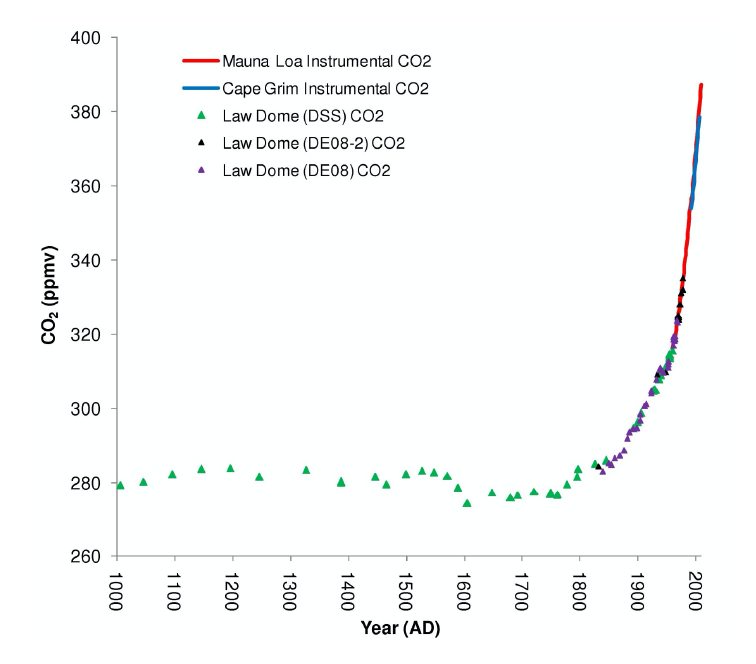
And how do we get CO2 concentration from ice cores? Ice has little bubbles of air in it.
These bubbles of air trapped in the ice core record what gases were in the atmosphere at
that time. As the next year’s snow falls, the older snow gets compacted, but the air bubbles
are still there. This process continues year after year, decade after decade, century after
century and so on.
Then an ice core scientist comes along and drills an ice core (long cylinder of ice) to collect
information about past climate from the ice. They use a lot of fancy machines to first work
out how old the ice is at points all the way down the core. They then extract the gases from
the air bubbles in the ice to work out what the gases are, and the quantities of different
gases along the core – from the youngest ice at the top all the way back to the oldest ice at
the bottom of the core. This provides a picture of how greenhouse gases have changed over
time.
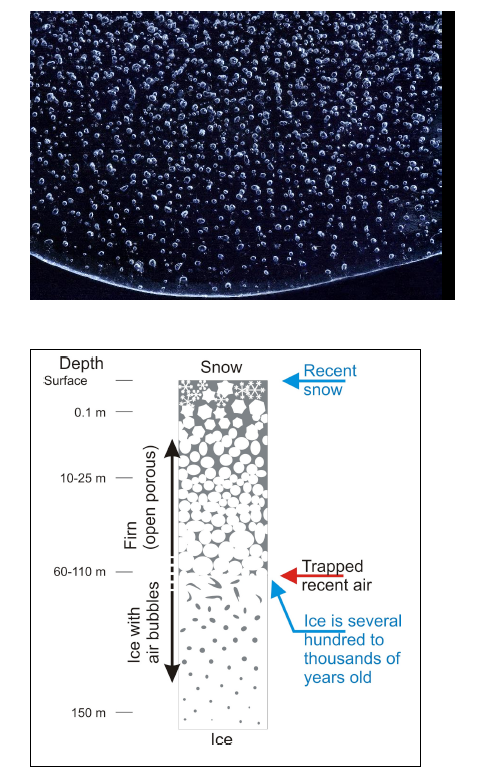
Figures supplied by Dr Tessa Vance, IMAS, UTas
Could the Earth ever enter another ice age? The short answer is quite probably, but maybe not for a very long time. However, nothing is certain, especially with the current human-induced changes now occurring. To explain why the answer is probably, we can look at what we know about past climate.
The Earth’s climate has varied over millions of years (see Figure 1). You can see that it was very warm around 56 millions years ago, and very cold around 25,000 years ago. The temperature has generally increased since about 20,000 years ago. But you can also see that there are a lot of ‘little’ ups and downs’. If you look at Figure 2, this shows variations over the last 800,000 years. The line in the middle is temperature. You can see that there are semi-regular periods of colder temperatures (glacial periods, or what some people call ice ages) that last for tens of thousands of years. The warmer (inter-glacials) and colder periods (glacials) can be related to a number of factors that affect Earth’s climate from ‘outside’ the Earth. We call these external forcings.
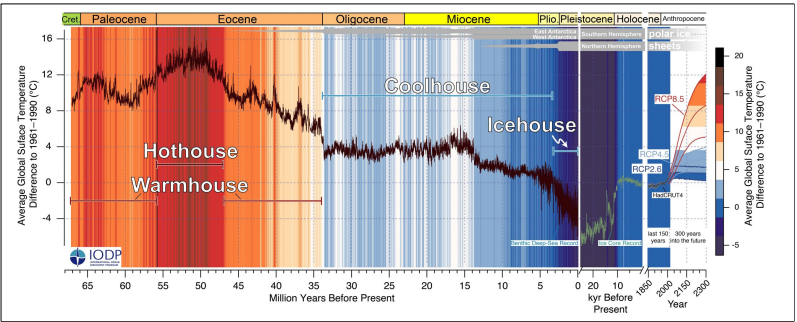
Source of Figure: Westerhold et al. 2020 Science
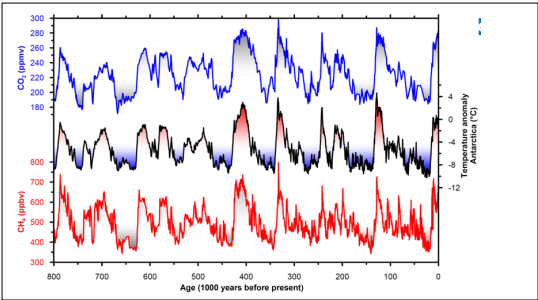
One of the important external forcings of glacial and interglacial periods is related to how earth travels around the sun. About 100 years ago, a smart guy from Serbia called Milutin Milankovic realised that there were three important ways the Earth’s orbit around the sun changed over long time periods. We can call these, stretch, wobble and roll (see Figure 3). These have periods (or cycles) of thousands of years. If you look at Figure 2 again, you can see that warm temperature periods occur around once every 100,000 years (give or take). This is very similar to the period of how Earth’s journey around the sun changes over time (stretch). So, around every 100,000 years, our orbit becomes more ‘circular’ or ‘less elliptical’, so we are closer to the sun. When our orbit becomes more elliptical, we are further away from the sun for much of the time, and our climate is cooler. The other two cycles are also important, but less relevant to your question. They will have important impacts on seasonal differences in the hemispheres and day lengths from the equator to the poles. In Figure 4, there’s a plot of the cycles over time, and down the bottom is a plot of stages of glacial and interglacial periods.
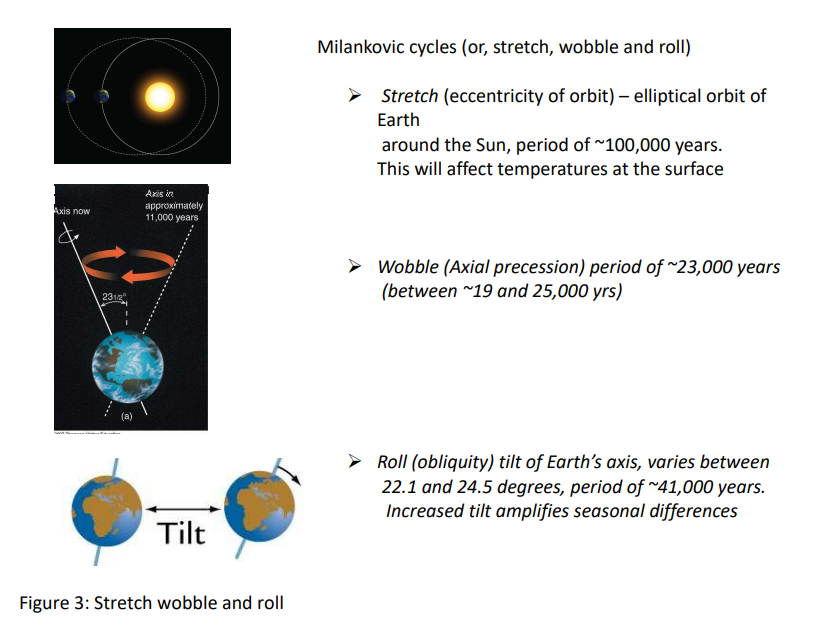
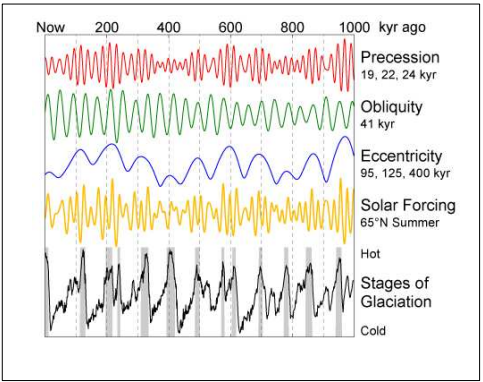
There are also other factors that affect the Earth’s climate that come from ‘outside’ the Earth (we can call these external forcings). You have probably heard of sunspots. There have been periods when there are less sunspots (the sun is cooler). When the sun is cooler, the Earth is cooler, too. These also have an impact on Earth’s climate, but on much shorter time scales (generally decades).
So, the longer answer to your question is that there are some factors that affect Earth’s climate that come from outside. These have big impacts on our climate and can ‘set up’ positive feedback loops meaning that when one thing happens it leads to another process which then causes some thing else. Like dominoes falling over. Or maybe like when you get up in the morning feeling a bit grumpy and say something not so nice to your brother or sister. They’re then nasty back to you and you get grumpier. When you go to school you’re still grumpy and take it out on your friends who then get grumpy with you. This would be positive feedback because one bad thing leads to another bad thing (or if you got up happy and said nice things…etc. That would also be positive feedback).
It is hard to know what will happen in the future with man-made climate change which is warming our planet very quickly. If we continue release CO2 as we are at present, we are unlikely to experience another ice age any time soon. Our orbit of the sun is currently quite ‘circular’ (or least elliptic) but is slowly becoming more eccentric. So, it is reasonably likely that some time in a little less than 100,000 years the Earth may enter another glacial period.
What it will look like then is another matter altogether.













